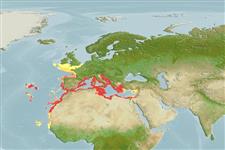Common names from other countries
Issue
Muraena augusti (Kaup, 1856) is considered as a valid species by Jiménez et al. (2007: Ref. 58348). Page to be created soon.
Environment: milieu / climate zone / depth range / distribution range
Ecology
Marine; reef-associated; depth range 1 - 801 m (Ref. 58348), usually 100 - 300 m (Ref. 58348). Subtropical; 52°N - 13°N, 32°W - 36°E
Eastern Atlantic: south of British Isles to Senegal, including the Mediterranean, Azores, Madeira, Canary Islands, and Cape Verde.
Length at first maturity / Size / Weight / Age
Maturity: Lm 75.5, range 69 - ? cm
Max length : 150 cm TL male/unsexed; (Ref. 12382); common length : 80.0 cm TL male/unsexed; (Ref. 3397); max. published weight: 6.5 kg (Ref. 58348); max. reported age: 38 years (Ref. 58348)
A nocturnal and territorial species (Ref. 12382), commonly lurking in holes, and writhing snakelike through crevices, under rocks or corals. Feeds on fish, crabs and squid (Ref. 12382). It seldom attacks unless provoked (Ref. 3256). A gonochoristic species (Ref. 32169). Utilized fresh and eaten broiled, boiled and baked; the skin can be used for leather (Ref. 9987).
Migrate to offshore waters to spawn (Ref. 98745).
Smith, D.G. and E.B. Böhlke, 1990. Muraenidae. p. 136-148. In J.C. Quero, J.C. Hureau, C. Karrer, A. Post and L. Saldanha (eds.) Check-list of the fishes of the eastern tropical Atlantic (CLOFETA). JNICT, Lisbon; SEI, Paris; and UNESCO, Paris. Vol. 1. (Ref. 4450)
IUCN Red List Status (Ref. 130435)
CITES (Ref. 128078)
Not Evaluated
Threat to humans
Traumatogenic (Ref. 4690)
Human uses
Fisheries: minor commercial; aquarium: public aquariums
Tools
Special reports
Download XML
Internet sources
Estimates based on models
Preferred temperature (Ref.
115969): 13.1 - 16.2, mean 14.4 (based on 181 cells).
Phylogenetic diversity index (Ref.
82804): PD
50 = 0.5010 [Uniqueness, from 0.5 = low to 2.0 = high].
Bayesian length-weight: a=0.00056 (0.00048 - 0.00066), b=3.27 (3.23 - 3.31), in cm Total Length, based on LWR estimates for this species (Ref.
93245).
Trophic level (Ref.
69278): 4.2 ±0.61 se; based on food items.
Resilience (Ref.
120179): Very Low, minimum population doubling time more than 14 years (tmax=38.1; tm=7.1; K=0.078).
Fishing Vulnerability (Ref.
59153): Very high vulnerability (79 of 100).
Climate Vulnerability (Ref.
125649): Moderate to high vulnerability (53 of 100).
